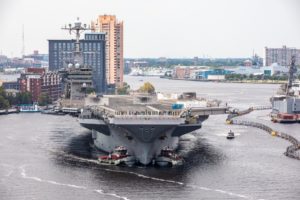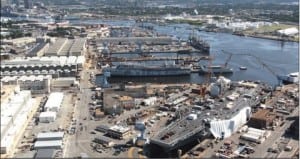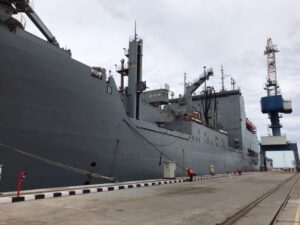Top Navy officials this week promoted the idea of adding more public shipyards to improve ship maintenance.
Speaking during the annual Surface Navy Association symposium on Wednesday, Adm. Daryl Caudle, Commander of U.S. Fleet Forces Command, emphatically said there is a good argument for the need to add at least a fifth public shipyard.

“Of course. I need six! I need enough capacity in our shipyards to drive the backlog down to zero…I can today, if I had the backlog chipped down, have a more effective, larger fleet today.” Caudle said on Wednesday during the Surface Navy Association symposium.
“I’ve got a pretty good sized Navy, too much of it’s being held in abeyance in our yards. And so whatever the solution set is, we’ve got to knock down thinking that I’ve got to just do this with a limited set of options – four public yards,” he continued.
The Navy currently is limited to four public shipyards that conduct the vast majority of maintenance on nuclear-powered submarines and aircraft carriers: Norfolk Naval Shipyard, Portsmouth Naval Shipyard, Puget Sound Naval Shipyard and Intermediate Maintenance Facility, and Pearl Harbor Naval Shipyard and Intermediate Maintenance Facility.
Caudle argued when he joined the Navy there were about eight public shipyards, but when the Defense Department decided to reduce to four “we went to the bone there. We went to the place where that was exactly optimized to do exactly what was needed as if we were never going to have a problem: take any battle damage, do emergent repairs, and things like sequestration come along, and things like COVID come along.”
He said the current public yard capabilities have no ability to expand to compensate when something derails the service.
“That’s a problem. And because of that, you get this compounding effect, and we just continue to stack ships up and not get them back into the fight. So again, yes, we need to be thinking about what we do to increase that capability,” Caudle said.
In November, Program Executive Officer for Attack Submarines (PEO SSN) Rear Adm. Jonathan Rucker said the Navy was planning to start a scoping study within a year that will take about two years to determine if the service needs a fifth public shipyard. This includes examining the Navy’s needs after the 20-year Shipyard Infrastructure Optimization Program (SIOP) to modernize the current yards is complete (Defense Daily, Nov. 4).
Speaking to reporters following his discussion, Caudle said the Navy’s struggles with ship maintenance and new construction delays “are to me the most significant problem the Navy faces. It is at the center of the Venn diagrams of every one of my problems. If I get ships out of the maintenance period on time and deliver the ships I’m paying for on time, then the size of the Navy just gets larger by that very nature.”
Caudle cited submarine maintenance as an example of the current dynamics, arguing the submarine force class maintenance plan calls for 20 percent of the fast attack submarine force to be in deep maintenance, which translates to 10 submarines out of a force of 50 vessels.

“Right now 19 submarines that are either in drydock, in availabilities, or sitting pierside because their hull expiration has been met and can’t go into the yard because I don’t have dry docks. So imagine if I was on time, my submarine force would be nine ships larger. That is a significant number.”
He also underscored that while the Navy is paying to procure two Virginia-class attack submarines per year the contractors are only delivering 1.2 vessels annually.
The attack submarines are built by General Dynamics’ Electric Boat [GD] and HII’s Newport News Shipbuilding [HII].
“So in five years, instead of delivering 10 fast attack submarines, I got six. So where’s the other four? So my force was already four submarines short,” reducing the force structure.
Caudle said he favors doing whatever it takes to get shipyard, depot and pierside maintenance improved. During the panel discussion, he noted private shipyards are starting to help conduct submarine maintenance via HII [HII] and General Dynamics’ Electric Boat [GD].
He said while that kind of partnerships is essential to helping him chip away at the backlog the companies need to get plans that makes sense for their risk model so that “they invest in the workforce, the space, the capitalization, tooling, and all the training necessary to do ship maintenance, or they’re just not going to be able to do it.”
“So if I’m going to partner with them, we got to come in and partner with them. So I think everything has to go on the table here. I really do,” he continued.
Secretary of the Navy Carlos Del Toro also showed an openness to ultimately adding a fifth public shipyard, but also said the Navy needs to look at more shipyard capacity in the Asia Pacific region to help respond in the event of a conflict with China.
“We need new approaches. We need more innovation, more investment, maybe more shipyards. …we need to be able to repair and revive ships as close to the conflict as possible, so that these vital national assets can get back into the fight very quickly. It’s no secret that any high end conflict is likely to be in the Asia Pacific region and that’s why we’re looking to create significant shipyard capability in the Pacific forward deployed,” Del Toro said on Wednesday.
Speaking after his discussion, Del Toro told reporters he is considering all options for additional shipyard capabilities in the Western Pacific region and is starting discussions with Navy leadership on what can be done.
“I’m beginning to have discussions with our entire Naval Sea Systems Command, with all our PEOs, the senior leadership of the Navy about anything and everything that we can actually do to get our ships out of shipyards faster – either in new construction, or for availability, or for emergent repair as well, too. So we’re exploring different opportunities across the globe, actually. But here in the United States, as well too. Which means, you know, taking a look at you know, if we were to create a fifth public shipyard, for example,” he said.

A new public shipyard is “no easy task, it’s a long term task, it’s not easy to execute, but we ought to start thinking about this to get to a better place than we are today,” he continued.
The U.S. Navy has some shipyard repair and maintenance facilities in Japan and Guam, but the U.S. government in 2022 also negotiated with India to have some Military Sealift Command (MSC) ship work conducted at the Larsen & Toubro Ltd. shipyard in Kattupalli near Chennai, India.
The first ship under that arrangement, Lewis and Clark-class dry cargo ship USNS Charles Drew (T-AKE 10), successfully underwent maintenance work in August. (Defense Daily, Aug. 18).
Del Toro told reporters the Navy will likely conduct more maintenance work at that shipyard “ “to test out the repair capability that they actually have there. But they did a great job on the first ship.”
Del Toro also said the Navy “should look at other opportunities in the Philippines, and Japan and other places as well too, where it’s needed.”